by Vivian Flynt © 2016
Question: “I’ve been looking at getting an English Shepherd. I’m disappointed they don’t come in merle. Why is that?”
Short Answer: Sables. Merling is incompatible with sables. A long time ago ES breeders decided they could have one or the other, but not both. Need more? Okay, here’s the back story:
In the years following World War I, when O.O. Grant first began his campaign to save our wonderful English Shepherd dogs from extinction, there was one color pattern that was strictly taboo – merle. Although Mr. Grant later admitted color has always been a contentious issue in the ES breed, even from the get-go, he still found consensus when it came to merling. Quite frankly, no one wanted it.
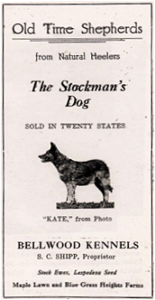 By the late-19th and early-20th centuries, dog breeders had seen firsthand the perils of doubling up on the merle gene. Today, as they were back then, double merles are commonly born deaf, blind, and excessively white. Double merles lack pigment, sometimes to the point that they are all-white. It’s this lack of pigment in certain vital areas – the eyes and the inner ear – that’s responsible for the hearing and sight impairments, but it also causes extreme sensitivity to sunlight and a propensity towards skin cancer.
By the late-19th and early-20th centuries, dog breeders had seen firsthand the perils of doubling up on the merle gene. Today, as they were back then, double merles are commonly born deaf, blind, and excessively white. Double merles lack pigment, sometimes to the point that they are all-white. It’s this lack of pigment in certain vital areas – the eyes and the inner ear – that’s responsible for the hearing and sight impairments, but it also causes extreme sensitivity to sunlight and a propensity towards skin cancer.
Right: a brochure of Old Time Shepherd breeder S.C. Shipp of Lebanon, TN. Circa 1930s. Mr. Shipp describes his OTS as coming in a variety of colors, including “black and blue spotted.” The first English Shepherd litter appeared in the United Kennel Club’s 1929 studbook, while the first Old Time Shepherd litter was recorded by UKC in 1931.
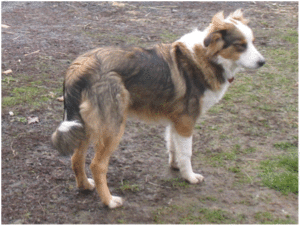
Lark, a 6-month-old, lightly shaded sable & white English Shepherd.
Given the severity of double merle’s pleiotropisms, English Shepherd foundation breeders preferred to steer clear of merles. So the merles were relegated to the OldTime Shepherds (a cousin to the English Shepherd breed), while English Shepherds became a non-merle breed. But as breeders of another merled cousin to English Shepherds ─ the Australian Shepherd ─ were to discover decades later, sable complicates the expression of merling.
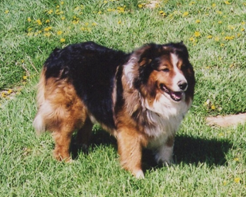
Nick, a heavily shaded sable & white English Shepherd. His overlay is so dark that Nick resembles a black tricolor.
Sable is a colloquial name we English Shepherd folks have given to a couple of coat colors in our breed – true sable and clear sable. With shades ranging from pale gold to deep mahogany, sable is an eye-catching color pattern. Unfortunately, both types of sabling can hide merle, making it way too easy for breeders to double up on the merle gene and inadvertently produce dogs with serious health issues. In an effort to stop double merles, Aussie breed standards from the 1970s on made all sables a disqualification.
The descriptor clear sable is a misnomer, mainly because true sables always have banding on their hair. True sable English Shepherds can be tipped or shaded, but will always have some expression of black (or liver, if the dog has liver pigment on its nose) along the hair shaft. If it’s a really heavily shaded true-sable sheppy, the dog can even appear to be black and tan.
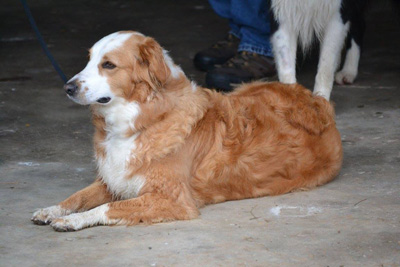
Babe, a clear sable & white English Shepherd.
Although self-colored, note that Babe lacks any dark overlay.
Dogs we call clear sables are genetically e-locus tans. It’s a recessive gene (“e”) that inhibits the expression of dark pigment. Because it’s recessive, a clear sable English Shepherd must carry two copies of the gene (“ee”). No matter if the dog carries the gene for dominant black; as long as it has two “e” genes the expression of that darker pigment will always be restricted. Unlike a true sable, the hair shaft on an e-locus tanis the same color throughout.
Merling is dominant and is thus represented by the capital letter “M”. Because it is dominant, no dog can be a carrier for merle – if it has the gene, it will be merled. Normal, healthy merles are heterozygous (“Mm”), meaning they carry one copy of the gene.
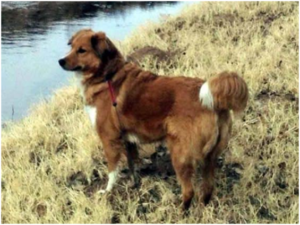
Lassen, a phantom merle Old Time Scotch Collie as an adult.
The merle gene dilutes random sections of the coat to a lighter color, leaving patches of the darker base color remaining. These blotches can be any size and can be located anywhere on the dog. There might even be as little as one patch of merling, making the presence of merle easy to overlook. Additionally, long-haired dogs, unless shaved, can be difficult to identify as merled. Such dogs are referred to as cryptic merles. The presence of sabling (either true sable or clear sable) effectively hides the merle gene, making the dog appear to be a non-merle. Such dogs are called phantom merles.

Lassen, an OTSC phantom merle as a puppy. She’s the sable pup in the middle, beside her blue merle littermate. As a wee-born sable pup, the merle Lassen carried could be identified by the small black spots on her back. This is, as far as I know, the only way to identify a phantom merle aside from a genetic test.
When there is no indication the merle gene is present, breeders can inadvertently cross two merled (“Mm”) dogs together, resulting in double merles (“MM”). While some double merles may be fine, most will suffer one or more of a wide range of congenital problems, including deafness, blindness, sterility, and serious heart conditions. Sadly, many must be put down because their problems are so severe.
English Shepherd breeders should consider themselves fortunate that our breed is non-merle. We can safely enjoy our healthy, vigorous English Shepherd dogs with their coats of many colors ─ including sable ─ without any worries of producing deadly double merles.
─ Author Bio ─
Vivian became enamored with English Shepherds in 1965. Starting in the mid-eighties, she bred sheppies under the It’za prefix. She now partners with William Clark as Botetot English Shepherds. In addition to having published the English Shepherd Advocate in the late-nineties, she has written numerous articles about the breed for various publications. Vivian lives in the Blue Ridge Mountains of southwestern Virginia.